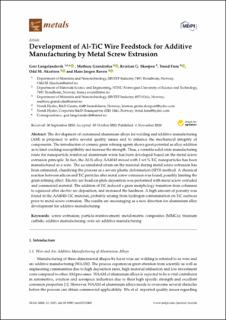| dc.contributor.author | Langelandsvik, Geir | |
| dc.contributor.author | Grandcolas, Mathieu | |
| dc.contributor.author | Skorpen, Kristian Grøtta | |
| dc.contributor.author | Furu, Trond | |
| dc.contributor.author | Akselsen, Odd Magne | |
| dc.contributor.author | Roven, Hans Jørgen | |
| dc.date.accessioned | 2021-01-05T11:59:28Z | |
| dc.date.available | 2021-01-05T11:59:28Z | |
| dc.date.issued | 2020 | |
| dc.identifier.issn | 2075-4701 | |
| dc.identifier.uri | https://hdl.handle.net/11250/2721466 | |
| dc.description.abstract | The development of customised aluminium alloys for welding and additive manufacturing (AM) is proposed to solve several quality issues and to enhance the mechanical integrity of components. The introduction of ceramic grain refining agents shows great potential as alloy addition as to limit cracking susceptibility and increase the strength. Thus, a versatile solid-state manufacturing route for nanoparticle reinforced aluminium wires has been developed based on the metal screw extrusion principle. In fact, the Al-Si alloy AA4043 mixed with 1 wt.% TiC nanoparticles has been manufactured as a wire. The accumulated strain on the material during metal screw extrusion has been estimated, classifying the process as a severe plastic deformation (SPD) method. A chemical reaction between silicon and TiC particles after metal screw extrusion was found, possibly limiting the grain refining effect. Electric arc bead-on-plate deposition was performed with metal screw extruded and commercial material. The addition of TiC induced a grain morphology transition from columnar to equiaxed after electric arc deposition, and increased the hardness. A high amount of porosity was found in the AA4043-TiC material, probably arising from hydrogen contamination on TiC surfaces prior to metal screw extrusion. The results are encouraging as a new direction for aluminium alloy development for additive manufacturing. | en_US |
| dc.language.iso | eng | en_US |
| dc.publisher | MDPI | en_US |
| dc.relation.ispartofseries | Metals;2075-4701 | |
| dc.rights | Navngivelse 4.0 Internasjonal | * |
| dc.rights.uri | http://creativecommons.org/licenses/by/4.0/deed.no | * |
| dc.subject | wire arc additive manufacturing | en_US |
| dc.subject | Additive manufacturing (AM) | en_US |
| dc.subject | titanium carbide | en_US |
| dc.subject | metal-matrix composites (MMCs) | en_US |
| dc.subject | particle-reinforcement | en_US |
| dc.subject | screw extrusion | en_US |
| dc.title | Development of Al-TiC Wire Feedstock for Additive Manufacturing by Metal Screw Extrusion | en_US |
| dc.type | Peer reviewed | en_US |
| dc.type | Journal article | en_US |
| dc.description.version | publishedVersion | en_US |
| dc.rights.holder | © 2020 by the authors. Licensee MDPI, Basel, Switzerland. This article is an open access article distributed under the terms and conditions of the Creative Commons Attribution (CC BY) license (http://creativecommons.org/licenses/by/4.0/). | en_US |
| dc.source.pagenumber | 17 | en_US |
| dc.source.volume | 10 | en_US |
| dc.source.journal | Metals | en_US |
| dc.source.issue | 11 | en_US |
| dc.identifier.doi | 10.3390/met10111485 | |
| dc.identifier.cristin | 1846041 | |
| dc.relation.project | Norges forskningsråd: 272402 | en_US |
| dc.source.articlenumber | 1485 | en_US |

